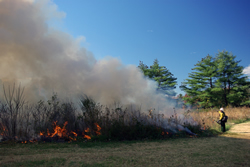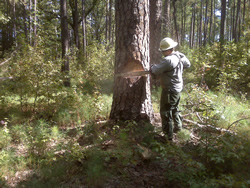
National Fire Plan Success Story
Autumn Burns Successful in Southeast National Parks
Congaree National Park and Cowpens National Battlefield, South Carolina
National Fire Plan - Fuels Reduction and Rehabilitation
2009

Brad Cope supervises ignitions in an area overgrown with blackberry and privet. NPS photo by Scott Withrow, Cowpens National Battlefield.

NPS faller Pete Jerkins prepares fireline at Congaree National Park by falling a hazard tree. Photo by John Torrance.
In autumn 2008, two very different national parks in South Carolina both benefitted from a change in the seasonality of their prescribed fire programs.
Cowpens National Battlefield commemorates the Battle of Cowpens on January 17, 1781, a turning point in the Revolutionary War. At the time of the battle, the landscape consisted of an open forest. Objectives for prescribed fire at Cowpens include hazard fuel reduction in the wildland-urban interface and restoration of the historic landscape. Previous burns at Cowpens have been conducted in the spring. On November 19, 2008, the National Park Service burned 164 acres of the National Battlefield. According to Fire Use Module Leader Pete Jerkins, “by burning before the dormant season we can have a more pronounced impact on privet mortality resulting in a more open understory.” With structure protection in place for the historic Scruggs House, the Fire Use Module and local cooperators used a ring fire strategy to ignite areas overgrown with blackberry and privet. Initial indications show that privet mortality was significant.
At Congaree National Park, also located in South Carolina, the National Park Service used an autumn burn to restore an ecosystem instead of a cultural landscape. Congaree preserves the largest contiguous area of old-growth bottomland hardwood forest remaining in the United States. Loblolly pine is an unusual component of these forests, but Congaree’s loblollies are some of the largest trees in the park. The park is also home to longleaf pine and Red Cockaded Woodpecker (RCW), two fire-dependent species. Like Cowpens, Congaree has been burned in the spring only until this year. On October 28 and 29, 2008, the National Park Service burned 630 acres of the park. Here the objective of burning before the dormant season was to reduce clonal reproduction of sweetgum (Liquidambar styraciflua). Despite higher-than-forecast humidity, the fire carried well in the RCW habitat. As NPS Fire Effects Monitor Wylie Paxton noted, “Overall, this was a successful burn and another step to achieving the long term objectives of restoring this area as a long-leaf pine (Pinus palustris) and Loblolly (Pinus taeda) savannah.”
In addition to resource benefits, these fall burns will also realize operational efficiencies. By completing a total of 794 acres in these two parks during the fall, the National Park Service will have more time to complete additional projects during the usual spring burn season. The first fall burns in the history of these two national parks were thus a success not only for them, but also for the entire Southeast Region.
Contact: Herbert “Pete” Jerkins, Module Leader, Cumberland Gap Fire Use Module, (276) 861-3418.